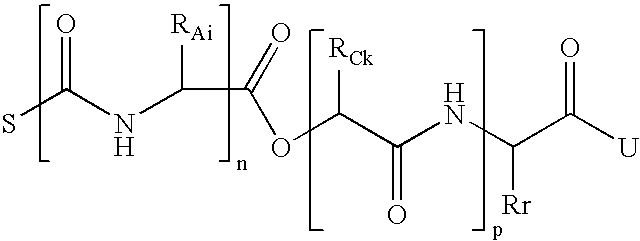Process for preparation of biodegradable polymers and resins from proteins, and plastics obtained thereby
a technology of biodegradable polymers and resins, applied in the field of plastics, can solve the problems of severe regulatory limits on the most difficult to dispose of waste, and the use of non-biodegradable plastics
- Summary
- Abstract
- Description
- Claims
- Application Information
AI Technical Summary
Benefits of technology
Problems solved by technology
Method used
Image
Examples
example 1
Deamination of the Protein Digest so as to Obtain a Protomer A
[0250] 69 g Bacto Tryptone (pancreatic digest of casein, Becton, Dickinson & Co.) was dissolved in 400 ml of 0.2 M aqueous solution of glycolic acid (99% Aldrich Chem. Co., St. Louis Mo., USA, Cat No. 12,473-7) with 0.1 g polypropylene glycol as an anti-foaming agent Aldrich Chem. Co., St. Louis, Mo., USA, Cat No. 20,233-9). The pH was 4.57±1.
[0251] The solution was transferred to a 500 ml stoppered jar. While stirring at ambient temperature, a sodium nitrite solution (10.53 g in 40 ml of water) was added under the liquid surface at a rate of 5 ml / hr. The solution was left to react overnight. Between 3.0 and 3.1 liter nitrogen gas were produced. The pH at the end of the reaction was 5.3±0.1.
[0252] Resulting was an aqueous solution of protomers of the present invention.
example 2
Preparation of the Free Acid Form of Protomer A
[0253] The solution resulting from Example I comprised protomer salts. To convert the protomer salts to free acids the solution resulting from Example 1 was mixed for 20 minutes at ambient temperature with 27 g Dowex ion-exchange resin (AG 50W-X8, 100-200 mesh) in H+ form. The ion-exchange resin (with cations) was separated from the solution by filtration and washed with 400 ml water to remove protomers incidentally associate with the resin. This was repeated an additional two times where the resin was washed each time with the same 400 ml of water.
[0254] After three ion exchange steps the filtrate containing the protomers and the washing water were combined to yield 900 ml of free-acid protomer solution having a pH was 2.2-2.3.
example 3
Polymerization of Protomer A to Obtain a Resin
[0255] 8 g of L-lactic acid (as a copolymer) was dissolved in 32 ml water and added to the combined filtrate / washing solution of Example 2 and evaporated under vacuum (30 μm Hg) to dryness. 2.5 g of bis-(2-ethylhexanoate)-tin were added (as a catalyst). The combined catalyst / protomer / copolymer was triturated to ensure even distribution of the components. The combined solids were maintained at 135° C. overnight under nitrogen. The resulting material was hard slightly brittle resin that was insoluble in water having a melting point of 150° C. The material was a thermoset plastic.
PUM
| Property | Measurement | Unit |
|---|---|---|
| temperature | aaaaa | aaaaa |
| temperature | aaaaa | aaaaa |
| temperature | aaaaa | aaaaa |
Abstract
Description
Claims
Application Information
 Login to View More
Login to View More - R&D
- Intellectual Property
- Life Sciences
- Materials
- Tech Scout
- Unparalleled Data Quality
- Higher Quality Content
- 60% Fewer Hallucinations
Browse by: Latest US Patents, China's latest patents, Technical Efficacy Thesaurus, Application Domain, Technology Topic, Popular Technical Reports.
© 2025 PatSnap. All rights reserved.Legal|Privacy policy|Modern Slavery Act Transparency Statement|Sitemap|About US| Contact US: help@patsnap.com



